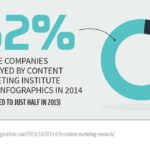See How Infographic Marketing Can Skyrocket Your SEO Today
Before the online bandwidth explosion made video the ubiquitous king of social media and website content, infographics reigned supreme as the most engaging, shareable, and potentially viral format of content marketing. At one point, infographics were three times as likely to be liked and shared than any other form of content. The landscape of online content is and all always will be an ever-evolving, so infographics may not be quite as explosively viral as they were in the early 2010s.
For a prolonged stretch, though, infographics made a profound impact on the way we view content and what the possibilities and expectations are for how fast and how much we can learn through visuals.
We learn more readily
It makes sense that visuals can be so much more effective for mass communication than words alone in today’s culture. So many communities both geographic and online feature broadly ranging disparities in education level, language, and dialects, so pictorial data can transcend communication the way it did thousands of years ago in cave drawings.
Whether the hurdle to copy-only articles is one of clarity or simply boredom, we are 3,000% more likely to read an infographic than a text-only article. It isn’t enough to acknowledge that infographics are more palatable to the human eye than a text-only article, it’s absolutely critical to any communication endeavor to recognize that strong visuals are an expectation for more learners than ever before.
We learn amid more information
One thing that has changed drastically in the last several decades is the sheer amount of information we are bombarded with. One study showed that approximately thirty years ago, the average person came across the equivalent of 40 newspapers worth of information every day. That may seem like a lot (especially if you’re old enough to remember what a newspaper is). But just two decades later, that number had more than quadrupled to 174 newspapers worth of data.
In that context, our brains have to choose what information to focus on, a decision that is more competitive than it has ever been. And eye-tracking studies reveal that relevant, informative images attract our attention much more than text alone or images that are considered generic, such as stock imagery.
We learn more permanently
So in that flood of information, more than our brains can possibly absorb or retain, information that is organized well and designed according to the way our brains learn in this age takes on unparalleled value both for us as readers and businesses hoping to make even a remotely lasting mark on customers or employees.
The good news is that the form information takes dramatically impacts how much of that information a reader retains. Studies have shown that when data is presented in purely verbal form, audiences are able to remember just 10% of that information after three days. However, when an informative picture or graphic accompanies that information, audiences were able to retain 65% of the information presented.
So, in this age where potential audiences are drowning in data, the advent of the infographic has been a game changer. It tells readers exactly where to look and presents the data in a way that is easy to process and to remember. We as marketers could bemoan the fact that, of the audiences who do choose to read our text, only 1 in 10 bits of information will stick—or we can celebrate in knowing we have a way to increase that retention more than 6 times over.
Infographics may not be the most-shared form of internet content anymore, but we should never lose sight of the fact that they are among the most attractive, most informative, and most memorable ways to package important information in an age of data-overload.
Learn more about how our infographic service can take you to the next level.







Leave a Comment